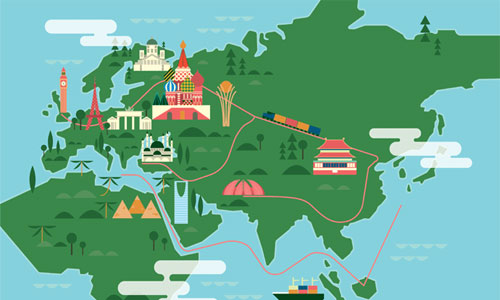Hosting four significant events: The Forum on China-Africa Cooperation (FOCAC), the 15th China-ASEAN Expo, the 21st Century Maritime Silk Road China (Guangdong) International Communication Forum and the Third Silk Road (Dunhuang) International Cultural Expo in September this year, China could take more practical step in promoting the Silk Road spirit and pursuing multilateral cooperation and win-win result.
The four events carry much more significance in promoting the Belt and Road Initiative which includes two mega projects: The Silk Road Economic Belt and the 21st Century Maritime Silk Road. The former links China with Central Asia, the Middle East and Europe on land while the latter unites the major sea trade of Africa, Europe, Oceania, South and Southeast Asia. That is, the MSR reiterates connecting the Asia-Pacific economic circle in the east and the European economic circle in the west by building a network of sea ports, linking the economic hinterland in China.
With the importance of the maritime trade and transport in the globalized world, economists believe that the MSR – which is intended to serve diplomatic, economic and strategic purposes – carries more weight than the land-based economic belt. The MSR will open a new chapter in the history of sea trade and it will offer an enormous opportunity to the world in general and to Europe, Africa, South and Southeast Asia in particular. This mega project urges all nations to play the “symphony” in tune.
Being the significant station of the MSR, Africa is of especial importance for China. For example, Senegal, Tanzania, Djibouti, Gabon, Mozambique and Ghana are all included in the Chinese investment plan as the development of roads, railways and ports are closely tied to one another in these regions.
In the FOCAC, the two sides, which form roughly 2.6 billion population, approved an action plan for bilateral cooperation in the next three years and pledged to step up building a community with shared future as President Xi Jinping pointed out in his keynote speech, “The over 1.3 billion Chinese people have been with over 1.2 billion African people in pursuing a shared future.”
This year’s China-ASEAN Expo was connected with the MSR, which is an indivisible part of the Silk Road Economic Belt. Since the adoption of the BRI five years ago, the two sides have promoted the Silk Road spirit and consolidated the steps to build a community with shared future. ASEAN countries are China’s third largest trade partner and China has been ASEAN’s biggest trading partner for nine consecutive years. To facilitate further trade, ASEAN countries believe that reviving the MSR is necessary and they also seek to align their economic activities in the frame of the BRI.
I believe that the importance of Silk Road Economic Belt will be similar to the 21st Century Maritime Silk Road and China has made great efforts in promoting both in the frame of the BRI. In other words China is seeking to promote the spirit of the Silk Road – i.e. peace and cooperation, openness and inclusiveness, mutual benefit and mutual learning. This year, China has hosted a number of expos and forums in its different provinces to win the regional and global support for the BRI and to show that China will open its door wider to the outside world. China will also host a highly remarkable expo in Shanghai in November.
Delivering a speech in the opening ceremony of the Third Silk Road (Dunhuang) International Cultural Expo on September 27, Afghan second vice-president Sarwar Danesh emphasized the significance of the Silk Road and said, “The ancient and historical Silk Road has been one of the oldest and longest commercial routes for exchanging commercial goods, knowledge, and culture of humankind that linked some of the biggest civilizations of the world, namely, China, India, Greece, Buddhism and Islamic Cultures to each other.”
The Silk Road is termed “Road of Dialogue” by the UNESCO to emphasize “dialogue among civilizations”, “intercultural and interreligious dialogue” and “rapprochement of cultures”. To increase mutual understanding, promote a peaceful coexistence, enhance the spirit of brotherhood and build a “community with shared future for mankind” through trade and people-to-people interactions, the world needs to revive the ancient Silk Road.
Since the proposal of the BRI in 2013, more than a 100 countries and international organizations have voiced their support to this mega project of the 1st century. Hope it will be the route of dialogue and communication and all nations could be the beneficiary of the BRI. As it is promised, it is hoped that peoples could learn about the culture of one another and be able to have a fair share in the BRI.
Home » Opinion » The Belt and Road Initiative Looms Large for the World
The Belt and Road Initiative Looms Large for the World
| Hujjatullah Zia

